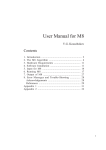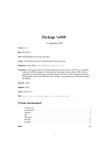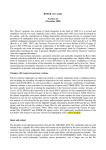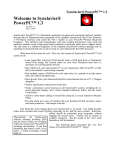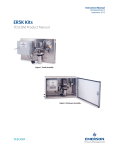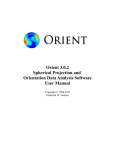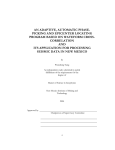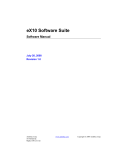Download User's Guide for Program AFT.
Transcript
Ninth Workshop on Non-Linear Dynamics and Earthquake Prediction 1-13 October 2007 User's Guide for Program AFT A.Soloviev International Institute of Earthquake Prediction Theory and Mathematical Geophysics Russian Academy of Sciences 84/32 Profsouznaya st., Moscow 117997 Russian Federation www.mitp.ru I. COMMON NOTATIONS The program is written in Turbo Pascal and C for PC compatible computers. It is intended to be used for • identification of main shocks and aftershocks in a catalog; • creation of a catalog of main shocks. The programming skill is not required from users. Some experience with computers would be helpful. To users. The program is modified from time to time according to the experience of its applications. Any suggestions or information on results obtained will be kindly appreciated. Please send both to Dr.A.A.Soloviev, International Institute of Earthquake Prediction Theory and Mathematical Geophysics, Russian Academy of Sciences, 84/32 Profsouznaya st., Moscow 117997, Russian Fedration Phone: +7 495 333 45 13, Fax: +7 495 333 41 24 E-mail: [email protected] 1.1 Catalogs The program operates on catalogs of earthquakes stored as non-text, binary files, i.e., the socalled MITPAN standard "20 bytes binary format" (see description below). Records in a catalog should be ordered by ascending time. Catalogs in this format can be prepared from data reported in other formats by using CompiCat (http://www.mitp.ru/soft/ecp/doc/mainindex.htmO. Each earthquake in the catalog is described by a vector (T, LA, LO, DEP, mb, ms, ml, mp) where T is the origin time; LA and LO are latitude and longitude of the epicenter in degrees and decimals (Western longitude and Southern latitude are negative); DEP is the focal depth in kilometers; mb, ms, ml, mp are four magnitudes (0 usually corresponds to unknown value of magnitude). The records in a file with the catalog are specified as follows. The first 4 bytes of the first record contain an integer, which is the total number of records in the file (the number of earthquakes plus 1). For all other records: Positions in a record 1-4 5-6 7-8 9-10 11-12 13-14 15-16 17-18 19-20 Contents time of the earthquake in minutes A.D. latitude, degrees multiplied by 100 longitude, degrees multiplied by 100 depth, km magnitude mb multiplied by 100 magnitude ms multiplied by 100 magnitude ml multiplied by 100 magnitude mp multiplied by 100 macroseismic intensity (not used usually in these programs) Type integer *4 integer *2 integer *2 integer *2 integer *2 integer *2 integer *2 integer *2 integer *2 Notation T LA LO DEP mb ms ml mp The earthquakes in a catalog should be in ascending order by time. 1.2 Menu The program has the user interface based on the window menus. We call a menu a set of windows on a screen. Each window is a box with a header and with one or several values inside. A value may be numerical, logical or text variable. User can move around the menu and select any window he needs. The current window is highlighted. It can be entered to change values. Some windows can be opened to enter the next level menu. The headers of such windows are enclosed in brackets, e.g. <Magnitude>. • • • • To move cursor around the screen or inside the windows, use arrows, Home, End, PgUp, and PgDn keys. To enter current window, press Enter. To accept value(s) in the window and to leave the window, press Enter. If cursor remains in the window it means that selected value is of wrong type or out of range. If you do not need some parameter of the string type, replace it by ' ' (i.e. press SpaceBar in that window). • • • To open the window and to enter the menu of the next level, use function key F2. To select files, use F9. To abort the program, use F10. The keys which can be currently used are shown in the bottom line of the screen. To accept all the values in current menu and leave it, returning to the previous level, press Esc. When it is possible, the hint 'Esc - Exit' appears at the bottom of the screen. In some windows values can be toggled by pressing + or -. In this case,'+/-' will appear in the bottom line of the screen. 1.3 'PROFILE' file The set of selected values of parameters can be stored in a separate file, called here 'profile'. The parameters are rather numerous, since the program is flexible and offers a wide variety of possibilities. At the same time, some computations may differ only in few parameters, while the rest remain the same. A profile is created in order to avoid the repetition in choosing the values of the parameters. Default values of parameters will be suggested if you do not use any profile. Several profiles may exist under different names. However, the extension of a profile should be .AFT. II. DESCRIPTION OF THE PROGRAM 2.1 Introductory notes As mentioned above the input of the program is a catalog of earthquakes in the standard 20 bytes format. Output is a catalog of main shocks. It is stored on a disk in the same format. In the catalogs of main shocks created by the program AFT mb is magnitude, ms is the number of aftershocks divided by 100, ml = mp = 0. The names of the catalogs should have the extension .DAT. Optional printout file has the name AFT.PRI. The program separates earthquakes into main shocks and aftershocks. Everywhere in these notes M is the magnitude of the main shock. An earthquake is identified as an aftershock of a preceding main shock if the following conditions are satisfied: • its magnitude does not exceed M; • the distance between their epicenters does not exceed R(M); • time difference does not exceed T(M); • modulus of difference in depth does not exceed H(M). Here T(M), R(M), and H(M) are empirical functions. If the conditions are satisfied for several preceding main shocks the earthquake is assigned to the latest among the strongest main shocks. For details of this definition of aftershocks see: Keilis-Borok,V.L, L.Knopoff, and I.M.Rotwain, Nature, 1980, 283: 259-263. For each main shock the following statistics are given in the printout: • The number of aftershocks b{e{ij) during the time interval e(i) after the main shock; here e(l) < e(2) < ... < e(j) < T(M)J < 5. • The weighted sum Sigma (sg) counted for these aftershocks. The value of b{e{\)) divided by 100 is recorded in ms position of the output catalog. After a strong earthquake (i.e. main shock with M > M$) the count of b(e(i)) and sg is terminated for all preceding main shocks. However, the identification of aftershocks is carried on. 2.2 Parameters for definition of aftershocks Limitations on magnitude of the aftershock Ma may be of the following types: Abs - Mai < Ma < Ma2, Rel - M - dMl < Ma < M - dM2, No - no limitation. Here M is the magnitude of the main shock, and the constants Mai, Ma2, dMl, dM2 are specified by a user. Limitations on depth of the aftershock Ha may be of the same types: • Abs- H a l < / / a < H a 2 , • Rel - H - dHl < Ha < H - dH2, • No - no limitation. Here H is the depth of the main shock, and the constants Hal, Ha2, dHl, dH2 are specified by a user. Limitations on the distance /?a between epicenters may be of the types Abs and No only: • Abs- /? a <Ral, • No - no limitation. Here the constant Ral is specified by a user. Limitations on time Ta between the main shock and its aftershock may be of the type Abs: Abs- r a < T a l . Here the constant Tal is specified by a user. 2.3 Limitations as function of M We consider main shocks in magnitude range M\< M < M2. This interval can be subdivided into intervals by k points c\: M\<c\ < ... < Ck <M2. Limitations of type Abs on magnitude, depth, distance, and time, namely Mai, Ma2, Hal, Ha2, Ral, and Tal, may be common (notation-'Mono') for all M or be different (notation 'Poly') for different intervals. For example, consider the following limitations on Ma: for Mi = co < M < ci - Mal(l)<M a <Ma2(l); for c\<M<c2 - Mal(2)<Ma<Ma2(2); for ck < M < ck+i = M2 - Mal(k+l)<M a <Ma2(k+l). Here [a, a+i) are magnitude intervals with different limitations and Mal(i), Ma2(i) are corresponding limits. The number k of points of division should be less than 10. 2.4 Menu [Control] window. '???' in this window means some inconsistence in the selected values of the parameters. If there is 'OK1 in the window, one may finish parameter selection. Enter the 'Control' window to get explanations in the first case or to start execution in the second. [Type] window. In this window one may select, whether full amount of information will be displayed during the program execution [Type-ON], or just the necessary minimum [Type-OFF]. [Print] and [Protocol] windows. If in the [Print] window you select value ON, then the file for printout will contain complete output. If you select OFF in the [Print] window, then you have an option to create a smaller printout with information about the set of the selected parameters. To do this, choose the value ON in the window [Protocol]. The program selects from the input catalog a subcatalog, for which the separation of earthquakes into main shocks and aftershocks is carried out. This selection is determined by the time, magnitude, and depth intervals and the area. The time interval is determined by windows [Time from] and [Time to] Definition of the input magnitude is made by window [<Magnitude>] The following options can be selected in this window mb (ms, ml, mp) - the magnitude mb (ms, ml, mp) will be chosen only from input catalog without any transformation. Limitation for the selection has to be specified for this magnitude only by entering (using function key F2) the menu of the next level. common - common magnitude M is calculated in one of the following ways: a) M = max {J{mb)j{ms)f(ml)J{mp)}; b) M = mm{f(mb)j(ms)f(ml)f{mp)}; c) according to priority in sense of specified preferences. For example, suppose the priority is mb, mp, ml, ms. Then M=f(mb), if mb is not 0, M=J{mp) if mb=0 and mp is not 0, M=J{ml) if mb=mp=0 and ml is not 0, M=f(ms) if mb=mp=ml=0 and ms is not 0. Another example: if priority mb, mb, mb, mb is indicated then the program deals with input magnitude mb only. Here/(m) = A-m + B, values of the coefficients in f(mb),j{ms),f{ml), and/(mp) may be different. Method (Max, Min, Priority) of calculation of the common magnitude has to be specified in window [Select] by entering (using function key F2) the menu of the next level. The coefficients A and B for recalculation of magnitudes and limitations ([Magn from], [Magn to] for the common magnitude are specified in the same window. The depth interval is determined by windows [Depth from] and [Depth to] Area for selection of earthquakes [<Area>] The program selects the earthquakes with epicenters from an area specified in geographic coordinates. The boundaries are included. This area can be: Rectangle [<Area>-Rectangle] Rectangle is specified by the intervals of latitude and longitude. It may cross longitude 180°. [<Area>-Polygon Over] Polygon [<Area>-Polygon] Polygon is specified by coordinates of its vertices (their total number should not exceed 20) and should not contain a pole. It may cross longitude 180°. [<Area>-Rectangle Over] If a rectangle or a polygon crosses longitude 180° then it should not cross longitude 0°. Coordinates of an area have to be entered in the next level menu. Open window <Area> to view and change them. In the Polygon option program allows to view it by pressing F8. The value of Sigma for each main shock may be displayed during execution of the program. One may limit the displaying of the main shock to those with the number of aftershocks exceeding some threshold. [Type Sigma-ON] [Min Number] To set all the parameters for aftershock selection and identification, described above, move the cursor to the window <Functions> and press Enter or F2. Specified value(s) Window Number of magnitude intervals, k + 1 [Number of Lines] Mi, c\, c2,..., c k , M 2 [Interval] (boundaries of magnitude intervals) c, d, and/for calculation of Sigma = Zc\0dM'f [c] [d] [f] Mo [Strong] For each magnitude interval: Mai, Ma2, dMl, dM2 [Magnitude] Hal, Ha2, dHl, dH2 [Depth] Ral [Distance] Tal [Time] e(l), ... , e(5) [Timel], ... , [Time5] (time interval boundaries)







